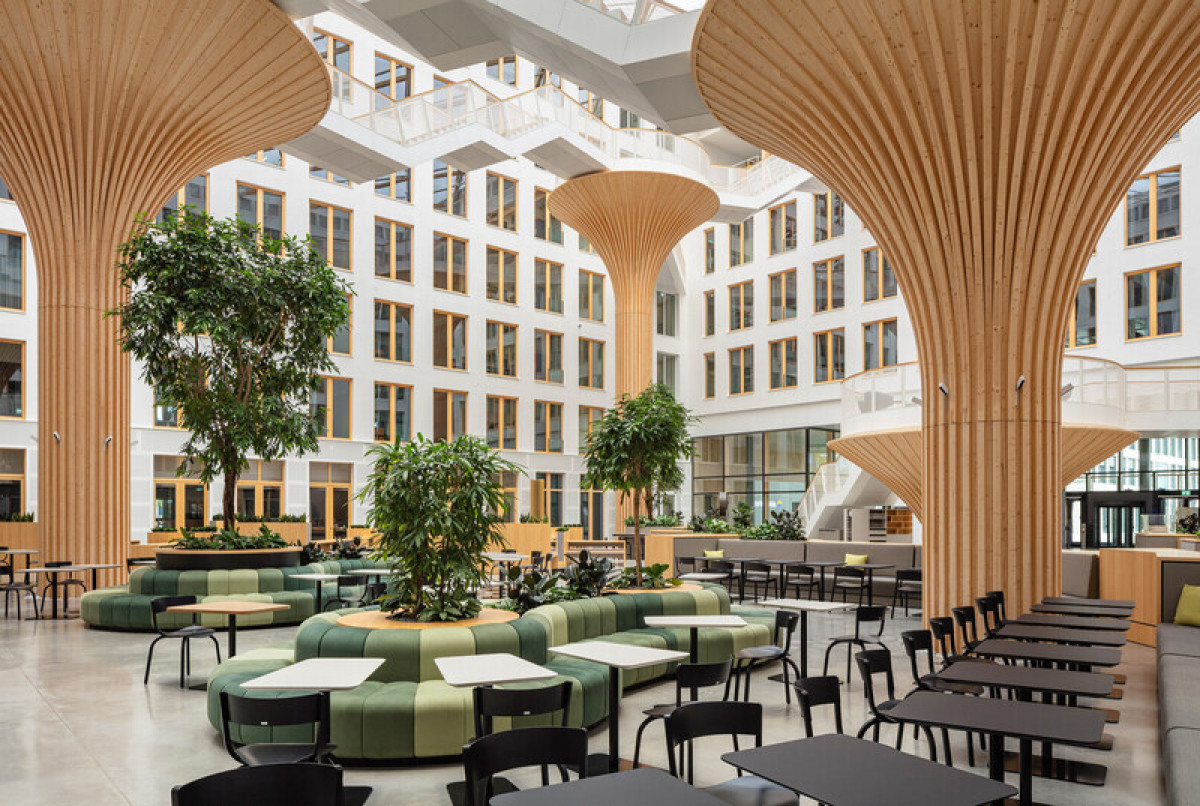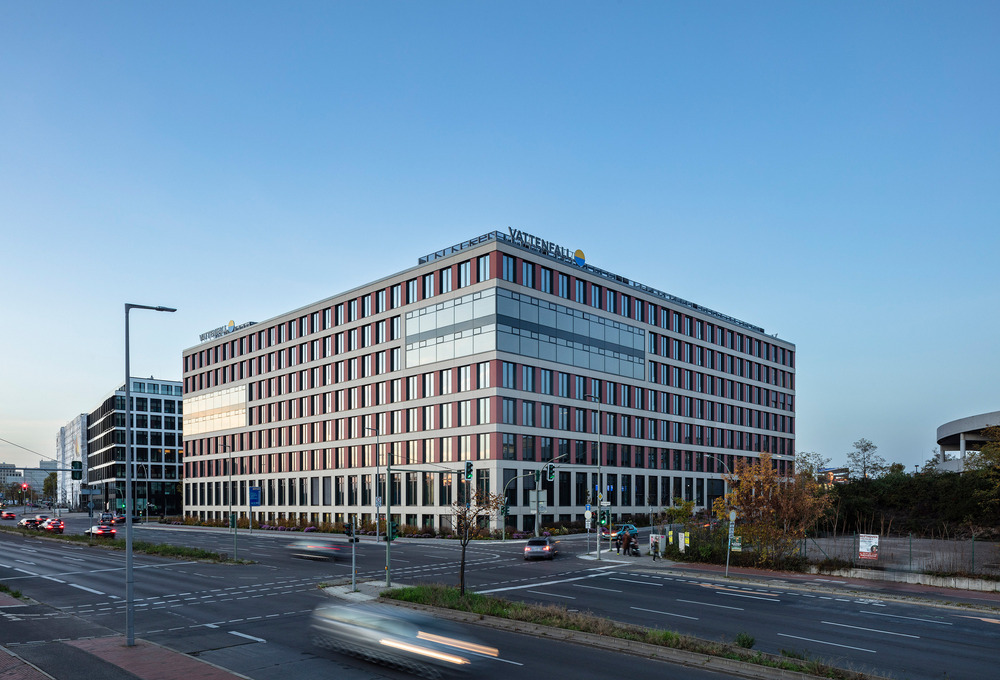09 Jun 2023

TCHOBAN VOSS Architekten proudly introduces EDGE Suedkreuz Berlin, a seven-storey office complex consisting of two buildings with a total floor area of approximately 32,000 m². The complex stands on an approximately 10,100 m² site and has been built using sustainable, climate and resource-saving techniques, as well as modular hybrid-timber construction techniques.
Also Read | Interior stylist Bhawana Bhatnagar on smart lockers at residential spaces
The larger of the two freestanding buildings contains approximately 20,000 m² of floor space, making it the largest hybrid-timber building in Germany, and one of the largest in Europe. The German Sustainable Building Council (DGNB) certified the project as Germany's most sustainable building in 2022. Since summer 2022, it has served as the new German headquarters for energy supplier, Vattenfall.
Also Read | Visioarq wins Architizer 2022 Architecture + Wood

The area around Berlin Suedkreuz regional, long-distance, and S-Bahn station, part of the so-called ‘Schoeneberger Linse’, is developing into a new urban district with an attractive mix of functions (housing, work, culture, and trade). The new office complex is part of a new urban district. Its planning involved restructuring the area between Sachsendamm, Hedwig-Dohm-Strasse, Hildegard-Knef-Platz, and Lotte-Laserstein-Strasse.
Also Read | 4 ways to style your interior spaces with copper
The smaller of the two buildings (the ‘Solitaire’) is an elongated freestanding building which continues the line of the façade of the larger office building. The latter is a quadrangle-type structure (the ‘Carré’) with an irregular trapezoidal footprint. The two buildings form a street front facing Hedwig-Dohm-Strasse. In the direction of Südkreuz Station, they create a new urban plaza with green spaces and seating.
The Carré building
The heart of the Carré building is a spacious, light-filled atrium. A two-storey entrance lobby with a clear height of seven metres facing the plaza in front of the building opens up the massive, strictly gridded volume, and directs the gaze firmly towards the building’s impressive interior. The 26-metre-high atrium is covered by a transparent ETFE foil roof carried by a wooden-truss construction. The continuous floor-to-ceiling windows in the offices, the glazed entrance area, and the large panoramic window in the building’s lounge additionally contribute to the abundance of daylight.
Also Read | Shiro Kuramata’s Samba-M shines again with Ambientec at the supersalone in Milan
A central highlight is the four treelike shapes of different heights which grow skywards under the foil roof as if in a greenhouse. Their lamellate spruce-wood structure gives them a resemblance to gigantic mushrooms. At ground level, green islands of tranquillity group themselves around their stems. The atrium is additionally enlivened by community and food areas.
The crowns of the so-called ‘Trees’ carry platforms for recreation; these form green leisure and communication zones at various heights. The largest is 14.87 metres high, and has a platform with a diameter of 6.20 metres; the lowest is 4.28 metres high, with a diameter of 7.20 metres. These structures are linked by filigree steps with white railings, which, on the other side of the classical building core, lead via the platforms to the adjacent floors of offices.
Also Read | Kareena Kapoor Khan’s new home in Bandra with European styled decor & wooden detailing
The fifth floor has a sky lounge with panoramic windows and a spacious external terrace. The lounge is openly linked to the atrium space and, like the offices, may be reached on foot via the ‘tree stairs’.
In every part of the building – from the supports, beams, windows, and doors, to the claddings and railings – wood is visible in all interior areas. Each of the building’s inner corners contains a building core with a safety staircase and elevators.
The entire interior design concept, as well as the development of the new office worlds for Vattenfall, was developed and accompanied by the implementation by de Winder Architekten Berlin.
Also Read | Arabic Resin art decor launches by Artist Madhavi Adalja
The Solitaire building has a two-storey entrance lobby with a clear height of seven metres. Floors 2 to 7 contain offices, while the ground floor houses gastronomic, commercial, and retail spaces. Here too, wood is a ubiquitous architectural and design element. The building is entered from the new urban plaza. Vertical access is using a central core with a safety staircase and two elevators. The landscaped outside space of the lounge, on the building’s roof, has a garden-like quality to it.
Both the Carré and the Solitaire buildings have a flexible modular ground plan on all levels. This can be adapted to individual requirements. With an extensive deconstruction concept, the issue of circularity was integrated into the planning at a very early stage. The flexibility and reusability of the building are ensured, among other things, by avoiding load-bearing interior walls, a room height of at least 3m, a well-thought-out arrangement of the staircases, and the zoning of the technical building equipment.
Also Read | Designing a multi-themed room for a toddler
The four main pillars of the building's energy supply are sufficiency, efficiency, combined heat and power, and load management. In the process, conditions were created to sensitize users to a conscious, efficient use of energy. The office spaces are air-conditioned by suspended smart ceilings. A sufficient amount of daylight in the offices minimizes the need for artificial lighting.
The two buildings in the office complex share a basement garage, with 218 e-mobility spaces for tenants. The bicycle room contains approximately 100 bicycle places, including e-bikes; there are 32 additional spaces in outside areas. The office areas, as well as the associated ancillary and circulation areas, are barrier-free, and all outdoor areas are also designed to be accessible.
Also Read | oPTIK, a new interactive sound and light installation in New York City
The façades have a regular grid consisting of weather-resistant glass-fibre concrete panels. The grid is articulated by horizontal strips and coloured vertical panels. Pylons structure the façades vertically. Glass-fibre pilasters visually reinforce the socle section. The rhythmic façades have a restrained colour scheme which has been chosen individually for each of the two buildings.
Also Read | Tips to care for your houseplants this winter
Two different shades were selected for each façade. In the case of the Carré, the colours are Sahara sand for the horizontal strips and terracotta for the vertical structures. The reveals are visually set apart by their silver-grey colour. The Solitaire has corresponding colours: Sahara sand for horizontal elements, and silver-grey for vertical elements. The two buildings enter into direct dialogue with one another through their colours and dimensions.
The sustainable façade elements of the two buildings weigh only 30 kg per m² and are also recyclable. In addition, the façade absorbs CO2 from the air due to the thinly ground cement top layer, thus giving it a decarbonizing effect.
Also Read | New edb products Spring/Summer 2023
The glass bays with fixed glazing and MicroShade solar protection additionally accentuate the façades; these are one-storey in the case of the Solitaire building, and two-storey in the case of the Carré. The remaining windows are fitted with anti-glare protection and external sun protectors.
The construction of the buildings focused on reducing the CO2 footprint as much as possible, especially in terms of the weight of the complex, and on using sustainable materials that can be recycled according to the cradle-to-cradle principle. EDGE Suedkreuz Berlin is the first project in Germany to be recorded for building construction with a 100% match on the MADASTER material database. It has a material passport that allows the materials used to be reused and recycled.
The use of prefabricated modules had a positive impact on various aspects of the construction process. The wooden elements, such as wall and ceiling modules, were prefabricated, and then assembled and adjusted on the building site. This ensured a precise construction schedule and an especially time-efficient and economical construction process. The wall elements were made regionally in Neuruppin; the ceiling elements, in Lemwerder and Henningsdorf. Altogether, 1190 wood-hybrid ceiling elements, carried by 1280 glulam façade supports, and 445 multi-box wall elements with a total area of 16,000 m² were made.
Also Read | Timber hybrid office ensemble EDGE Suedkreuz Berlin
Natural material wood is everywhere in the interior and office spaces, making an important contribution to a lasting healthy indoor climate for users. Wood possesses a high heat-storage capacity, but limited thermal conductivity. Existing heat is retained for longer in the room than heat from other construction materials, while delayed cooling reduces the amount of energy required. Wood is also lighter and more energy-efficient to transport than mineral construction materials. This project used approximately 3500 cbm of PEFC-certified spruce.
Also Read | How to select a dinnerware set that matches your home decor?
Through the intelligent combination of wood with concrete, the modular hybrid solution from CREE-Buildings can save up to 50% CO2 per m² of floor area. Low construction weight, short shell construction times, high reliability in planning and costs, and long durability are other advantages of this construction method. The construction materials used in EDGE Suedkreuz Berlin are extensively recyclable using the principle of cradle-to-cradle recycling. Reinforced-concrete construction elements were kept to a minimum, being used for fire compartment separation or to stiffen the building. Wood and hybrid-timber elements were installed as the load-bearing framework, especially in the interior; concrete was used for the foundations and basement. The wooden supports and beams carry the building’s overall vertical loads. Compared to conventional reinforced concrete construction, the weight of the building could be reduced by up to 50% through timber hybrid construction. This also reduced the use of concrete for the foundation slab, which had an additional positive effect on this new office complex’s CO2 balance.
Also Read | Beginners guide: Creative ideas for styling your new living space
The stairs in the atrium of the Carré are designed as a metal construction to avoid unnecessary material consumption with high timber cross-sections and costly metal substructure. The design of the components responds directly to the strengths and qualities of the respective materials, promotes the saving of the resources used, and reduces the weight of the components. The roof structure weighs only
45 kg per m² due to specially developed metal nodes, ETFE foil, as well as filigree wooden components, and ensures greater lighting in the atrium below thanks to narrower cross-sections. At the same time, the roof construction can withstand wind loads of up to 100 kg, as each bar can not only bear tensile but also compressive forces.
Also Read | 10 kitchen design ideas inspired by farmhouse style
EDGE Suedkreuz Berlin received the DGNB Platinum certificate with the highest score ever achieved in Germany of 95.4%. In addition, the ensemble was certified with DGNB Diamond for its outstanding design and architectural quality. The project has furthermore received a WELL v2 Platinum certification.
Technical sheet